Differences between the United States and Europe mapped
This post may contain affiliate links. As an Amazon Associate, we earn from qualifying purchases.
The United States and the European Union are the most developed countries/supranational organizations. But the US and the EU are partners and competitors, especially in the worldwide marketplace.
Even though average Americans and Europeans have very similar lives, the US and the EU have many differences:
- The US is 50 states under one country, but the EU is a union of nations.
- The United States (9,826,630 km2 / 3,794,080 sq mi) is larger than the European Union (4,233,262 km2 / 1,634,472 sq mi).
- The US has a population of 328 million people, while the European Union has 447 million people (2020).
- Economically, the United States in 2020 had a GDP (PPP) of 21,440 trillion dollars ($67,426 per capita), while the EU had a GDP of 20,366 trillion dollars ($45,541 per capita).
Moreover, in Europe, crime is much lower; the average life is longer; schools are free or have low costs, and health care is universal. Most European countries have highly developed social organizations, and quality of life is higher (when measured in words, such as hours worked per week and income distribution).
Below is an atlas of maps that illustrate the differences between these two political and economic superpowers.
US-Europe size comparison

Climate
Comparing the latitude of America and Europe
The map below shows American and European cities’ comparative latitudes by changing them on the opposing continent.
Many European cities have warmer climates than comparable cities in America at the same latitude. This phenomenon is caused by the warm current of the Gulf Stream. You can compare the climate of cities here.

The US vs Europe sunshine duration in hours per year
Sunshine duration in the United States is much higher than in Europe.

Human Development Index of the US and Europe
The Human Development Index is a statistical compound index of life expectancy, education, and per capita income indicators. The Human Development Index in states of Eastern Europe is considerably lower than in most US states.
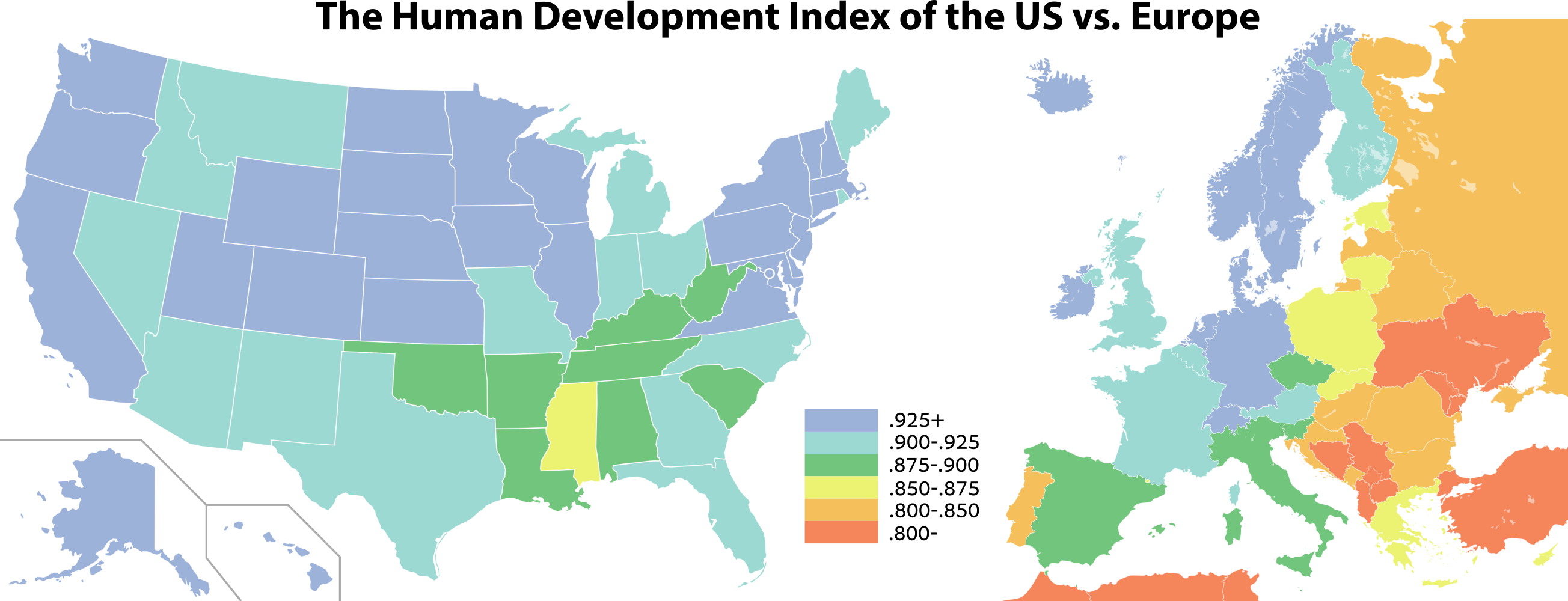
Unemployment rate
The map created by Reddit User maps_us_eu shows the unemployment rate across the US and the EU in January 2023. The US average unemployment rate is 3.5%, while the EU average unemployment rate is 6.1%.

Yearly median software engineer pay
Software engineering is one of the most popular and growing fields in the tech industry. A software engineer is responsible for creating, developing, and testing computer software. According to the U.S. Bureau of Labor Statistics, the number of job opportunities in software development is forecasted to grow by 22% from 2020 to 2030.
The number of software developers worldwide is rising each day, and nowadays, there are approximately 4.3 million developers in the United States, while Europe has over 6 million developers.
The map below created by Reddit user maps_us_eu illustrates the annual average median Software Engineer pay across the United States and the United Kingdom. Based on self-reported wages information.

Billionaire Concentrations
The maps below created by BrillianMaps show European countries and U.S. states by number of billionaires per capita and how much wealth billionaires hold.
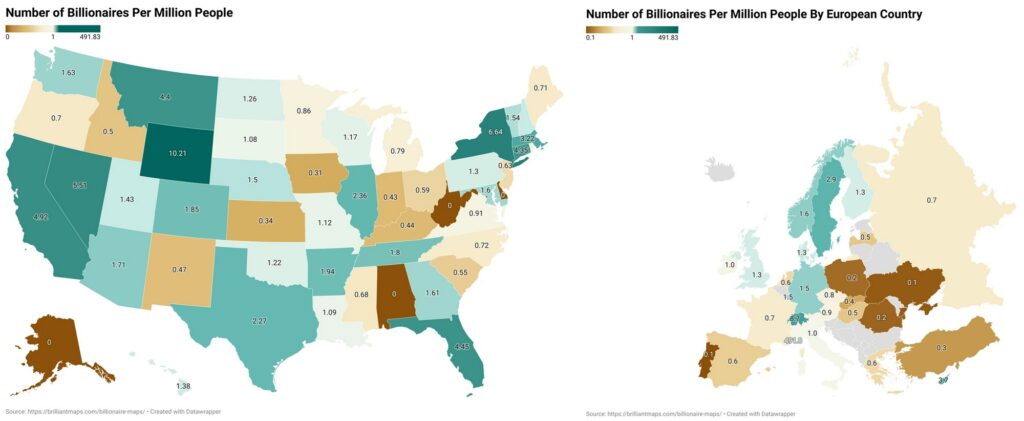
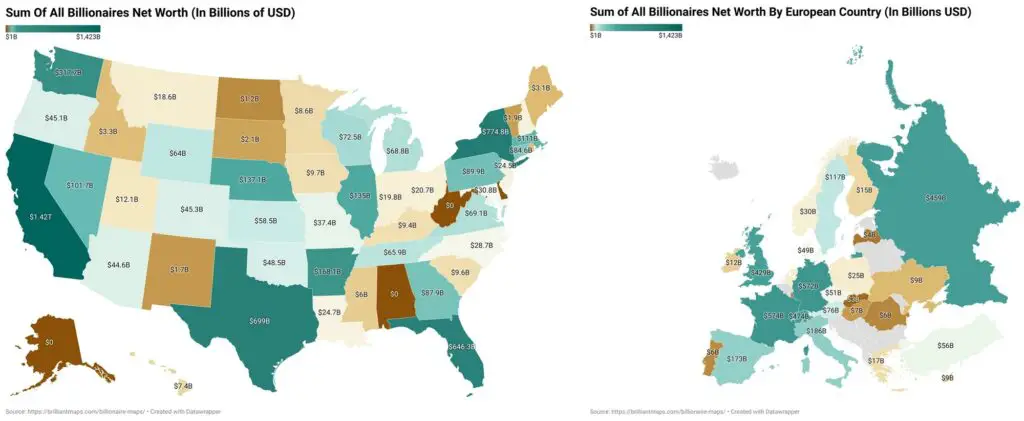
The United States hosts 840 billionaires, collectively amassing $5.822 trillion in wealth. Meanwhile, Europe harbors 695 billionaires, with their combined net worth reaching $3.405 trillion.
Median dwelling size in the U.S. and Europe
In the United States, the median size of a newly constructed single-family home is around 2,300 square feet. In contrast, the median size of a home in Europe is generally smaller, with variations among countries.
The maps below, created by Reddit user Dirrevarent, show the median dwelling sizes in the United States and Europe in square feet.
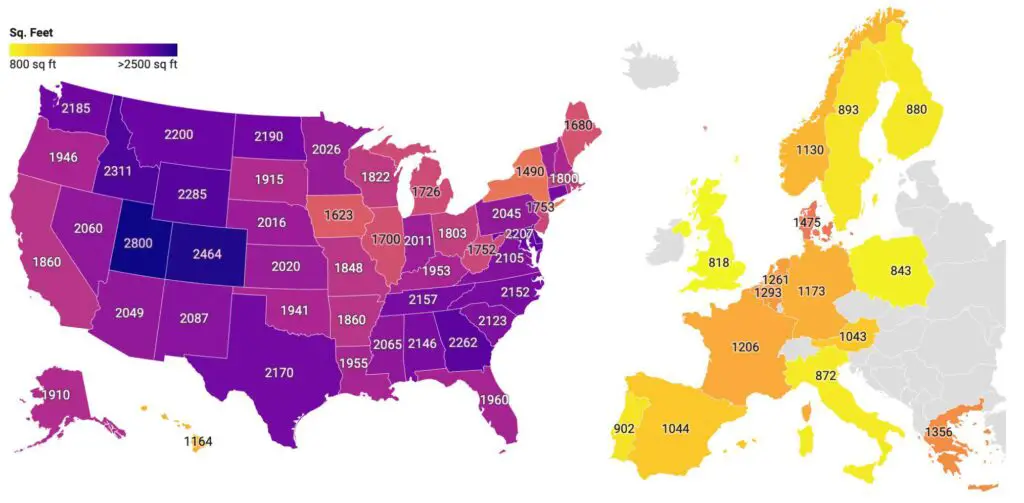
Factors such as population density, urbanization, and cultural norms influence the average size of dwellings.
Population age structure
Each region’s population age composition in the maps below is uniquely color-coded. Colors show the direction and magnitude of deviation from the center point, representing the average age composition. The hue component of color encodes the direction of deviation: towards yellow – more elderly population (65+); cyan – more people of working ages (15-64); magenta – more kids (<15).
In 2020, the median age of the US resident population – was 38.4, and in Europe – 43.1. The map of the evolution of the age structure of the United States you can find here.

Obesity rates in the United States vs. Europe
Obesity has become a significant health problem in the US: Over one-third of adults in America are obese. The United States exceeds nearly every European country in weight. West Virginia tops the chart with a staggering 40.60% obesity rate, making it the heaviest state or country on the map. In contrast, Romania is the European country with the highest obesity rate at 38.24%. On the other end of the spectrum, France has the lowest obesity rate at just 10.92%, outperforming even the US state with the lowest rate, Washington, D.C., at 24.7%. Below is the map of obesity rates in the US and Europe created using the latest 2024 data for US states from World Population Review and European countries from World Health Organisation data here.
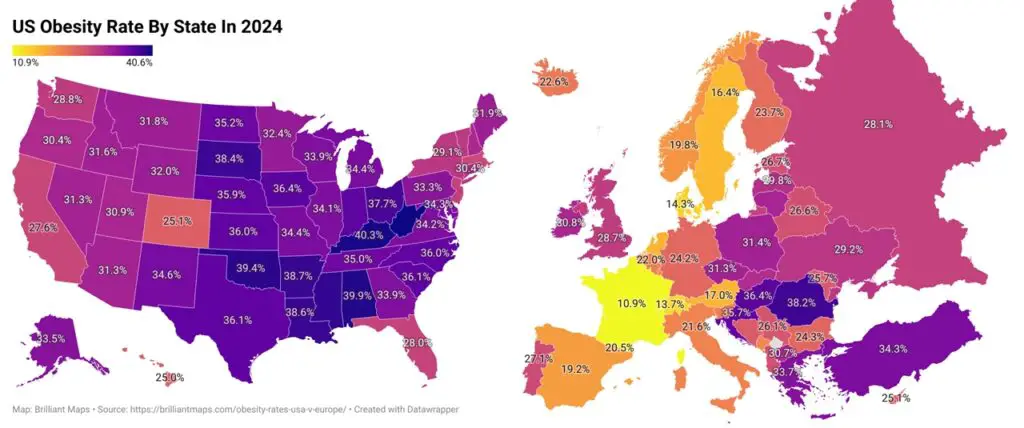
Percentage of Population “Absolutely Certain” God Exists
The residents of the United States are much more religious than the inhabitants of Europe.

A comparison of homicide rates in the US and Europe
The homicide rate in most US states is higher than in Europe. For clarification, the United States has an intentional homicide rate of 6.3, while Russia is 7.3. The map below shows the Intentional homicide rate in the United States vs. Europe in 2020.

US States with the highest homicide rates
| State | Intentional homicide victims per 100,000 inhabitants |
|---|---|
| District of Columbia | 28.2 |
| Lousiana | 15.8 |
| Missouri | 11.8 |
| Mississippi | 10.6 |
| Arkansas | 10.6 |
| South Carolina | 10.5 |
| Alabama | 9.6 |
| Tennessee | 9.6 |
| Illinois | 9.1 |
| Maryland | 9.1 |
European countries with the highest homicide rates
| Country | Intentional homicide victims per 100,000 inhabitants |
|---|---|
| Russia | 7.3 |
| Ukraine | 6.28 |
| Moldova | 4.10 |
| Mississippi | 10.6 |
| Lithuania | 3.7 |
| Montenegro | 2.9 |
| Andorra | 2.6 |
| Latvia | 2.6 |
| Liechtenstein | 2.6 |
| Belarus | 2.4 |
Incarceration rate
The map below, created by Reddit user flyingcatwithhorns shows the incarceration rate in the United States vs Europe. While the United States has only 5% of the world’s population, it has nearly 25% of the world’s prisoners.
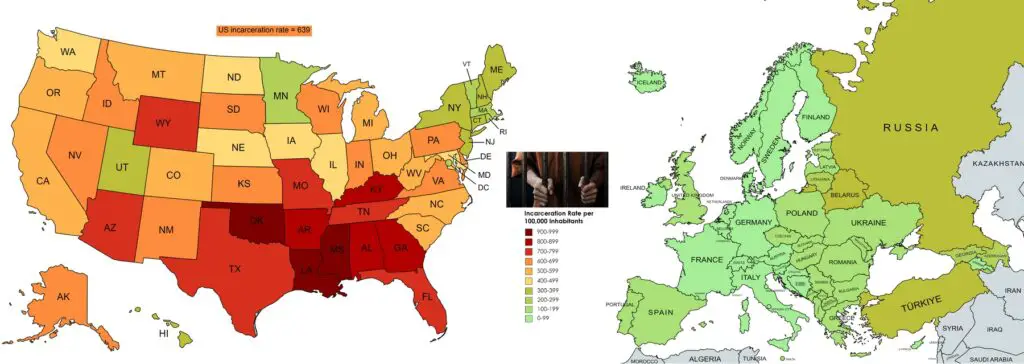
Road traffic death rate
The map below shows road deaths per 100,000 people in the United States Vs. Europe. Data from the World Health Organization, the European Commission, and the Insurance Institute for Highway Safety was used for making this map. The calculation included drivers, passengers, pedestrians, and bus and bicycle accidents.

COVID deaths
The map below depicts COVID-19 deaths per million in the US States and European nations (October 2020).

Age Restrictions
This map created by Reddit user Cartographer42 shows age restrictions in the United States and Europe (Driving, Voting, Drinking, Smoking). In the US, the purchase of tobacco and alcohol, unlike in Europe, is allowed only from 21.

Comparing Vegan-Friendly Locations: US States vs. European Countries
Maps created by dailymint.co highlight the most vegetarian and vegan-friendly locations in the United States and Europe. In the US, the District of Columbia leads with 54 vegan and vegetarian restaurants per million residents, followed by Hawaii (51) and Oregon (27). Europe shows a different picture, with Iceland topping the list at 38 restaurants per million, followed by Portugal (24.2) and the Czech Republic (21.6).
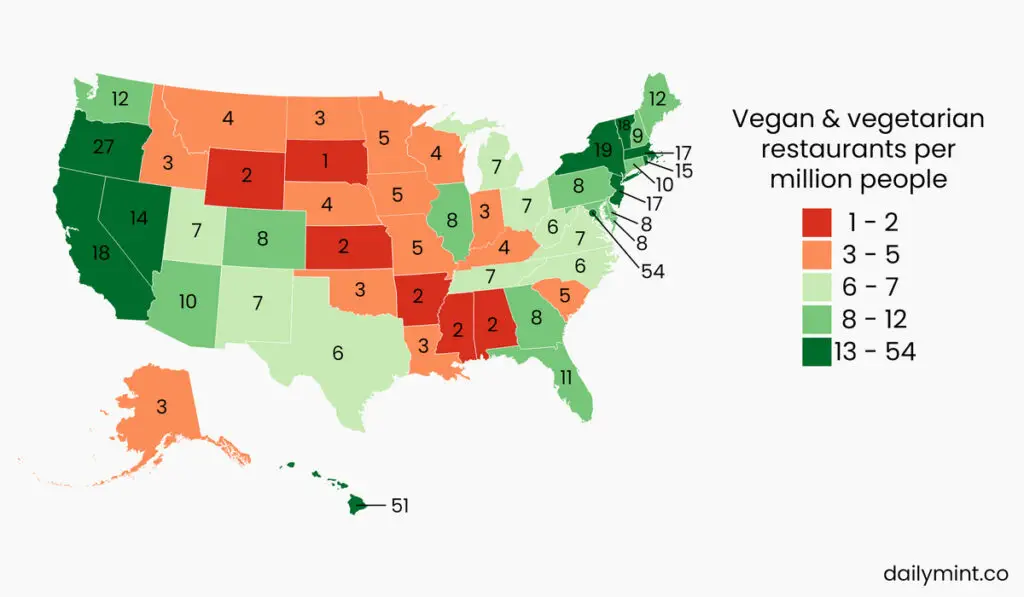
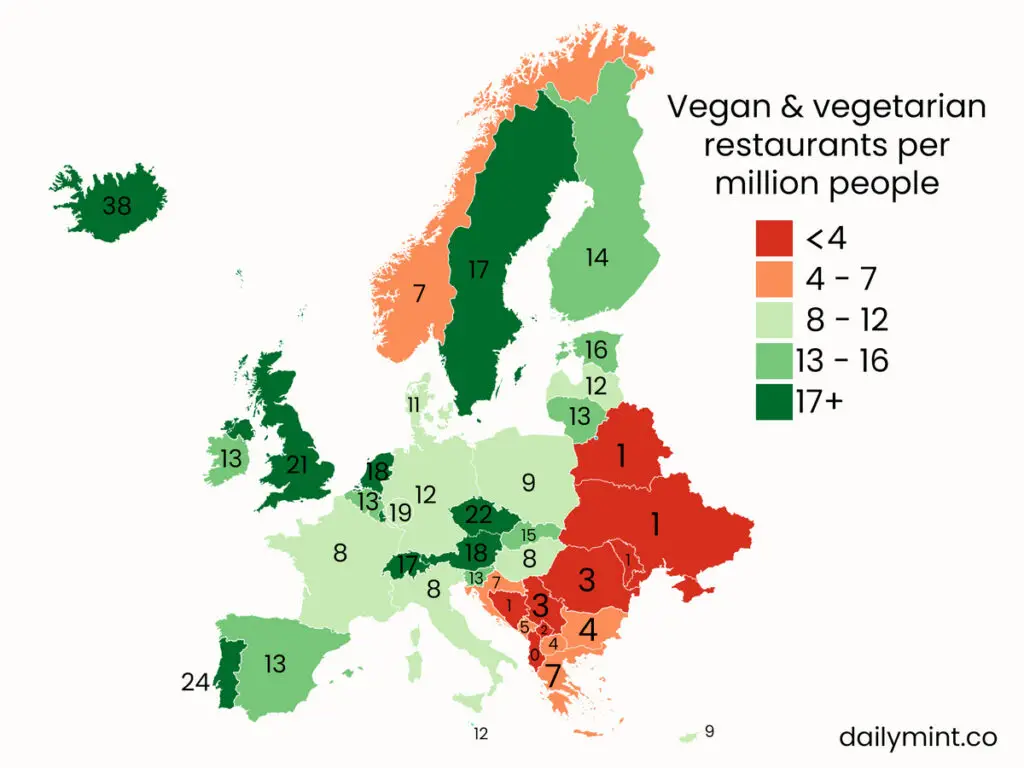
Interestingly, smaller populations often rank higher in vegan-friendliness in both regions, as seen in Hawaii and Iceland. The range of vegan-friendliness is wide: the US spans from DC’s 54 restaurants per million to South Dakota’s 1, while Europe ranges from Iceland’s 38 to Albania’s 0.3.
Cultural factors, urbanization, and tourism appear to influence these rankings significantly. Major cities and popular tourist destinations generally offer more diverse dining options, including plant-based ones. While these maps provide valuable insights, they measure quantity rather than quality or diversity of options.
For further exploration of US and European geography, consider these maps available on Amazon:



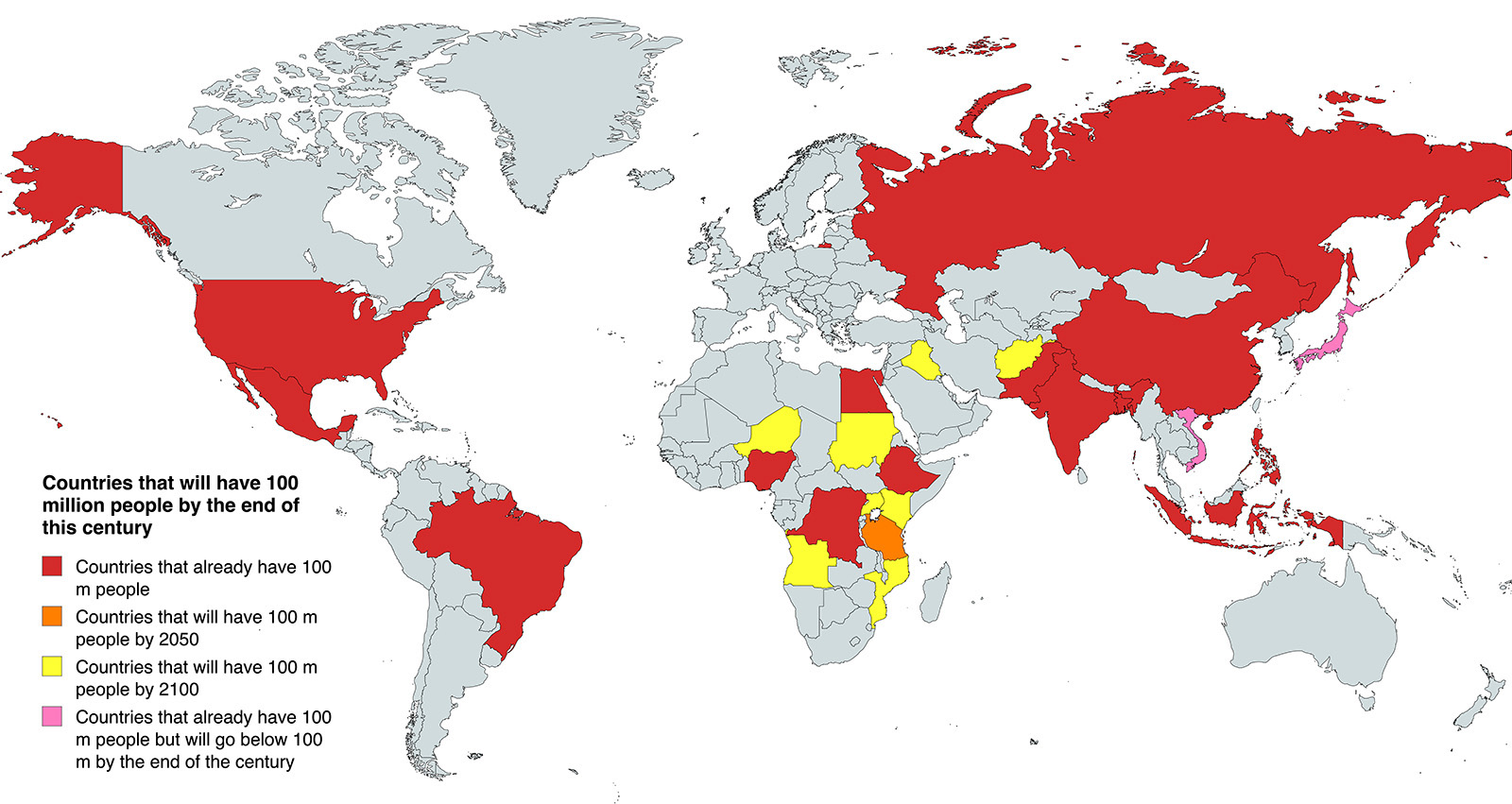





Interesting maps
I frequently tell my friends here in the US that we’re not as well off compared to Europe as they think we are.
Fun comparison, there certainly are trends with respect to particular states in the USA. Higher obesity often correlates with many different variables, if you were to stack the median household income vs usable income (post taxation), it’d be an interesting map as well. It’s clear from this, neither the USA nor Europe are having enough babies, any couple having less than 3 is making humans go extinct.
*Earth like this.
The smoking rate in Europe compared to the United States
Turkey is not European
The maps that are used are just created from data, so that doesn’t really matter.
But jet, a Part of Turkey/Türkiye lays in Europe and the country as a “EU Candidate” where it can become a real “candidate” (i dont think this will happen very soon)
Moskow is also located in Europe, But this country but is just like Turkey/Türkiye also particularly located in Asia.
Many other countries have territory in other countries (France, Spain, Portugal, The Netherlands, UK, enz….)
The maps also shows other countries like Georgia, Armenia and other countries.
This counties doesn’t a a part of Europe at all, but are historic and cultural connected to Europe.
So, are you discussing “Europe”, or “The European Union”? Because you seem to keep swapping back-and-forth depending on which you think makes the USA look superior…
The hell you meanUS look superior it makes it look quite worse
I agree, it is unclear. However, it seems to me that the particular data are skewed against the US, not making it look superior. The opening lines are very telling: “Moreover, in Europe, crime is much lower; the average life is longer; schools are free or have low costs, and health care is universal. Most European countries have highly developed social organizations, and quality of life is higher (when measured in words, such as hours worked per week and income distribution).” It fails to mention peoples’ treatment of each other in Europe and how one must fear which of these tribalist little countries is going to be the next one to decide to kill everyone.
… People treat eachother better in Europe…. and there’s no ‘tribalist little countries’… US education system?
As a person born and raised in Europe and educated in Europe as well as US, I agree with the statement that Europe is very tribal, so no it’s not the American education system.
This tribal aspect would be hard to notice /realize if you are an American living in Europe.
In general US and EU are very different, even though they appear to be similar, therefore, it is hard to make any definitive statements on which one is better, it all depends.
If I would be pressed for summarization I would say, America is like an ocean, you can go far but also drown easily, while Europe is like bunch of lakes, harder to go far as well as drown. Also, material things are easier to acquire in US, while “social” aspects of life are more accessible in EU. It all depends on someone’s preference
Which article did you read? Or by “better”, do you mean “higher”? As in higher obesity and homicide?
Then yes, the US is certainly better at getting morbidly obese and killing people.
Minimum age tobacco products in the US is 18, not 21. In ALL states.
I always thought it strange to compare Europe and the United States, constantly ignoring Canada, Mexico, Australia, New Zealand and South Africa–all countries with which America shares borders or values or demographics or economic relationships. The assumption seems to be that those other countries just don’t count, even though what happens in Mexico or Canada means much more to us than the same day in Bulgaria, Slovenia, Croatia, Belgium or Moldova!
Australia has much more in common with America on any average topic than America does with Hungary or Sweden. Such relationships matter, especially if you consider who will be around when the next earthquake rumbles under San Francisco, or a Hurricane crashes into the Carolinas. We need our neighbors as much as we need our allies, and truthfully, Canada, Mexico, Cuba, Jamaica, Haiti and the Dominican Republic are all allies, friends and neighbors! How about we treat them at least like we regard Finland, Portugal, Slovakia, The Netherlands and Greece–as though they exist?